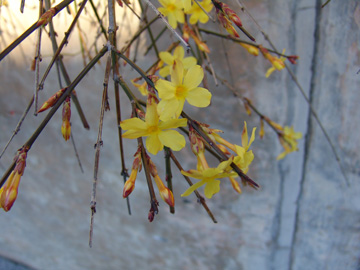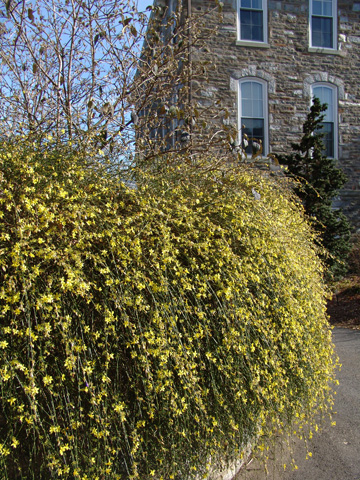Jasminum nudiflorum
The Scott Arboretum is in the unique position of serving a dual role, one as a public garden and the other as an active college campus. These dynamic roles drive many of the arboretum’s design decisions. For instance, as most of the student body is on campus during the winter months (as opposed to summer), we select plants with winter interest that can be appreciated by students during their daily campus travels. One such plant selection includes this month’s Plant of the Month, Jasminum nudiflorum, or winter jasmine. A late-winter beauty, I’ve heard Jasminum nudiflorum described as a necessary shrub for anyone with a winter garden.
I first noticed blossoms on our J. nudiflorum plants last week, after the pre-spring warm spell we experienced. Over the next month, more blossoms will continue to open all along the plant’s long, flexible bright-green arching stems. The end-effect will be a striking bright-yellow cascade effect, which can be seen along the retaining walls in our Winter Garden and to the north-west of Pearson Hall entrance to the John W. Nason Garden. This beautiful flower display serves as a nice reminder that spring is on the way.
Introduced from China in 1844, Jasminum nudiflorum has been awarded the Royal Horticultural Society’s “Award of Garden Merit“. It is a versatile plant that can be trained as a climber across wires or a trellis. But, it is equally nice-looking if allowed to cascade down a bank or over a wall, such as the way we grow it here at the Arboretum. J. nudiflorum tolerates most soils. It grows well in part shade to full sun, but will flower more profusely in full sun. Its flowers, though beautiful, have no fragrance.
Come and see what else is blooming this month at the Scott Arboretum (our beautiful Hamamelis collection, Chimonanthus, Galanthus, some early Helleborus, the list goes on!). Even though it is still winter, we (and our plants) are hard at work…you won’t be disappointed!







Meerredywef
Posted at 08:47h, 20 Marchvery intresting